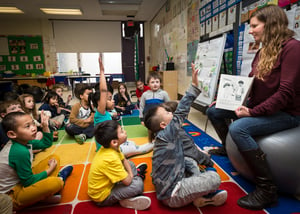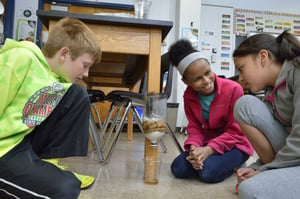E iE aims to create the next generation of problem solvers. To achieve this we know our engineering curricula needs to engage ALL students. When our founder Christine Cunningham started the EiE project, she realized she had an incredible opportunity to introduce a new discipline to students without worrying about previous experiences, entrenched models of learning, or biases against the subject. She began this process in earnest by reviewing literature on elementary school STEM education and talking to educators and engineers about what elementary engineering could look like. From this research, Cunningham and the EiE research team identified the fourteen inclusive design principles that we still use today to develop our curricula.
iE aims to create the next generation of problem solvers. To achieve this we know our engineering curricula needs to engage ALL students. When our founder Christine Cunningham started the EiE project, she realized she had an incredible opportunity to introduce a new discipline to students without worrying about previous experiences, entrenched models of learning, or biases against the subject. She began this process in earnest by reviewing literature on elementary school STEM education and talking to educators and engineers about what elementary engineering could look like. From this research, Cunningham and the EiE research team identified the fourteen inclusive design principles that we still use today to develop our curricula.
In this series, we’ll walk you through how our inclusive research-based and teacher-tested design principles have helped teachers across the country develop pedagogical practices that not only engage their students in engineering activities, but encourage their students to become deeper thinkers and more effective problem solvers. We categorize these principles under four larger categories: 1) set learning in a real-world context, 2) present design challenges that are authentic to engineering practice, 3) scaffold student work and 4) demonstrate that “everyone engineers” and everyone can engineer.
First up is setting engineering instruction in a real-world context because equitable, inclusive engineering experiences must demonstrate the relevance of engineering in the real world.
Use Stories to Develop Students’ Understanding of Engineering in the Real-World
 Each EiE curriculum unit starts with a storybook about a child who wants to solve a real-world problem using engineering. By setting stories in the real-world, youth are better able to see how classroom concepts connect to the real-world problems their communities face. Take for example this anecdote from a fourth- grade teacher who taught Water, Water Everywhere: Designing Water Filters, which challenges youth to remove tea, soil and cornstarch from water. During the unit, a Dominican student commented that effective water filtration was a problem in her home country as well. “Several months after [we] completed the challenge, she came into class and said, ‘Señora N., lo hice, I did it! I made a filter that gets the water perfectly clear…For my next challenge, my mother has arranged that when I return to the Dominican Republic this summer, I am going to visit a man at a water treatment plant who is working on the desalinization of ocean water for drinking water.’”
Each EiE curriculum unit starts with a storybook about a child who wants to solve a real-world problem using engineering. By setting stories in the real-world, youth are better able to see how classroom concepts connect to the real-world problems their communities face. Take for example this anecdote from a fourth- grade teacher who taught Water, Water Everywhere: Designing Water Filters, which challenges youth to remove tea, soil and cornstarch from water. During the unit, a Dominican student commented that effective water filtration was a problem in her home country as well. “Several months after [we] completed the challenge, she came into class and said, ‘Señora N., lo hice, I did it! I made a filter that gets the water perfectly clear…For my next challenge, my mother has arranged that when I return to the Dominican Republic this summer, I am going to visit a man at a water treatment plant who is working on the desalinization of ocean water for drinking water.’”
This is one amazing example of how a student developed an understanding of how engineering is useful in the real-world. As children’s author Andrea Beaty recently articulated, these stories don’t need to be about science or engineering but more “about perseverance and curiosity—because every kid has those traits. If we can help all kids look at [science or engineering] as a human endeavor, they’ll think ‘Well, I’m curious. Maybe I can try this experiment.’”
Provide Diverse Role Models
 In order to become engineers, youth need to be able to imagine themselves as engineers first! When students read (or listen to) stories with protagonists with whom they can identify, they begin to believe they could be engineers too. Our EiE storybooks, for example, are diverse by design. Our curriculum development team created a large table of all of our storybook characters to ensure that we featured role models from different races, geographic locations, family situations and abilities. We’ve heard from teachers often how their students have connected to our storybook characters. For example, Two years ago, Claudine Conover taught A Work in Process: Improving a Play Dough Process, which features a young Canadian girl who has Down’s Syndrome. At the time, twelve of Conover’s students had Down’s Syndrome as well. “When I read the book,” Conover told us, “the kids immediately made the connection that Michelle was just like them. I enlarged the illustrations so everyone could see them, and the kids were saying, ‘Like me, like me!’”
In order to become engineers, youth need to be able to imagine themselves as engineers first! When students read (or listen to) stories with protagonists with whom they can identify, they begin to believe they could be engineers too. Our EiE storybooks, for example, are diverse by design. Our curriculum development team created a large table of all of our storybook characters to ensure that we featured role models from different races, geographic locations, family situations and abilities. We’ve heard from teachers often how their students have connected to our storybook characters. For example, Two years ago, Claudine Conover taught A Work in Process: Improving a Play Dough Process, which features a young Canadian girl who has Down’s Syndrome. At the time, twelve of Conover’s students had Down’s Syndrome as well. “When I read the book,” Conover told us, “the kids immediately made the connection that Michelle was just like them. I enlarged the illustrations so everyone could see them, and the kids were saying, ‘Like me, like me!’”
Demonstrate How Engineers Help People
Research shows many students, particularly girls and underrepresented minorities, are attracted to “helping careers.” During a recent Atlantic panel “Cracking the Code,” our founder and director Christine Cunningham described how engineers have “made or touched 98% of what we interact within in the world” and how it’s important to make explicit connections between engineering and people, animals and the environment. We demonstrate how engineers help people in many of our materials and resources. For each of our Engineering Everywhere units, we’ve produced videos that depict real-world engineers working on real-world problems. After watching our video about vertical farms, youth who live in food deserts may be inspired to become agricultural engineers to help their communities gain better access to fresh fruits and vegetables. We’ve found if you show students how engineers help people, students will be more motivated to solve the challenges in front of them to help their communities thrive. Watch this young girl describe why she wants to be an engineer.








